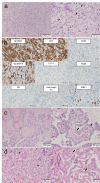Genetic Panel Test of Double Cancer of Signet-Ring Cell/Histiocytoid Carcinoma of the Eyelid and Papillary Thyroid Carcinoma: Case Report and Literature Review
- PMID: 35747011
- PMCID: PMC9213258
- DOI: 10.7759/cureus.25192
Genetic Panel Test of Double Cancer of Signet-Ring Cell/Histiocytoid Carcinoma of the Eyelid and Papillary Thyroid Carcinoma: Case Report and Literature Review
Abstract
Signet-ring cell/histiocytoid carcinoma (SRCHC) is a rare, aggressive neoplasm that often originates in the eyelid. We present a rare case of a 64-year-old male with SRCHC and papillary thyroid carcinoma (PTC) that underwent exome panel sequencing with next-generation sequencing (NGS). In addition, we reviewed reports of genetic mutations in SRCHC and compared them with our results. The imaging findings allowed us to recognize the differences in pathology between the left and right cervical nodes. For first-line treatment, an extended total maxillectomy with orbital exenteration and dissection of the left neck was performed. Two months later, total thyroidectomy and right neck dissection were performed. Two years after surgery, multiple bone metastases occurred. An exome panel sequence with NGS was used to determine the chemotherapy regimen. Notably, somatic mutations in cadherin 1 (CDH1), human epidermal growth factor receptor 2 (ERBB2), neurofibromin 1 (NF1), and tumor protein p53 (TP53) were detected. These mutations are rarely detected in PTC; therefore, cervical metastases are assumed to originate from SRCHC. To our knowledge, there have been no reports of simultaneous cancer of SRCHC and PTC. Somatic mutations in CDH1, ERBB2, NF1, and TP53 were detected in the exome panel sequence of the metastatic lymph nodes of SRCHC and correlated with previous reports of SRCHC.
Keywords: cadherin 1; double cancer; eyelid; genetic panel test; papillary thyroid carcinoma; signet-ring cell/histiocytoid carcinoma.
Copyright © 2022, Kuroki et al.
Conflict of interest statement
The authors have declared that no competing interests exist.
Figures



References
-
- Primary signet-ring cell/histiocytoid carcinoma of the eyelid: a clinicopathologic study of 5 cases and review of the literature. Requena L, Prieto VG, Requena C, et al. Am J Surg Pathol. 2011;35:378–391. - PubMed
-
- WHO classification of skin tumours. WHO WHO. https://publications.iarc.fr/Book-And-Report-Series/Who-Classification-O... 2018;11:182.
-
- Signet ring cell carcinoma of the eyelid - the monocle tumour. Mortensen AL, Heegaard S, Clemmensen O, Prause JU. APMIS. 2008;116:326–332. - PubMed
-
- Primary signet-ring cell/histiocytoid carcinoma of the eyelid: a "binocle" presentation of the "monocle tumor". Bernárdez C, Macías Del Toro E, Ramírez Bellver JL, Martinez Menchón T, Martinez Barba E, Molina-Ruiz AM, Requena L. Am J Dermatopathol. 2016;38:623–627. - PubMed
Publication types
LinkOut - more resources
Full Text Sources
Research Materials
Miscellaneous
